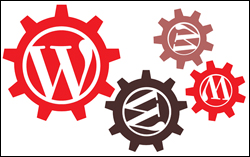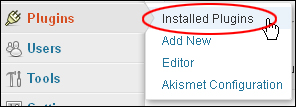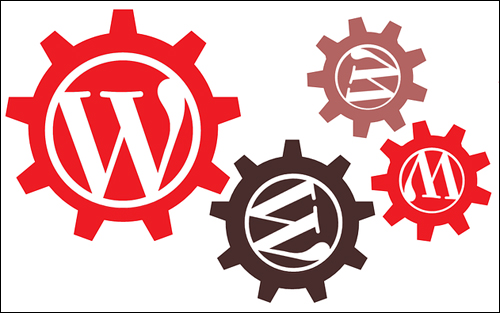 This tutorial is part of our WordPress Management tutorial series. In this step-by-step tutorial, you will learn how to update and delete WordPress plugins manually.
This tutorial is part of our WordPress Management tutorial series. In this step-by-step tutorial, you will learn how to update and delete WordPress plugins manually.
To learn how to update your plugins automatically using the WordPress built-in update feature, see the tutorial below:
***
How To Update And Delete Your WordPress Plugins Manually
WordPress lets you know when your plugins need updating.
For example, you can see how many plugins need to be updated from your WordPress Dashboard by looking at the ‘Plugins’ menu (in the example screenshot below, 7 plugins need to be updated) …

The ‘Plugins’ section also lets you know which plugins need to be updated and provides links to their download pages, as well as the option to update plugins automatically …

Most of the time, you should experience no problems updating your plugins using the WordPress built-in automatic update feature.
In some cases, however, you may not be able to update your plugins automatically.
Some Premium plugin developers, for example, choose not to add their plugins to the official WordPress plugin repository (WordPress only lists plugins in its repository that are 100% open-source) or may not allow automatic updates for their plugins in order to have control over the downloads and distribution of their software.
In addition, sometimes automatic plugin installations and updates can fail. This can happen in certain hosting environments, or due to misconfigured server settings, software bugs, conflicts with other plugins, or just simply for any other unknown reason …

If you cannot update plugins automatically (or don’t want to update plugins automatically), then use the methods described in the step-by-step tutorial below to upgrade your WordPress plugins to their latest version manually.
How To Update WordPress Plugins Manually: Step-By-Step Tutorial
Download the latest WordPress plugin installation upgrade files. This can be done from your ‘Plugins’ screen by clicking on the View version X.X.X details link below the plugin description …

When the “Plugin Information” screen opens up, click on the WordPress.org Plugin Page link …

The ‘Plugin Page’ opens up in a new window. Click on the plugin Download button …

A download window opens up. Make sure that “Save File” is selected and click Ok to proceed …

We recommend keeping all of your WordPress files (versions, plugins, themes, etc…) organized in a “WordPress” folder in your hard drive.
To learn more about creating an organized system for performing WordPress maintenance, see the tutorial below:
Locate your plugin download folder (or create one) and create a new folder for the new plugin version (1). Once you have done this, double-click on your new folder (2) …

Click the Save button to save the compressed plugin file into the new plugin version folder you have just created …

Once your plugin has been downloaded to your new plugin version folder, unzip (extract) the file …

Once you have downloaded the plugin file to your hard drive, there are two methods you can use to upload the updated plugin files manually to your server:
- You can upload the uncompressed (unzipped) folder to your server’s WordPress plugins directory using FTP
- You can upload the compressed (zipped) folder to your server’s WordPress plugins directory via cPanel File Manager

Let’s go through both methods now …
Method 1 – Uploading Your Plugin Files Via FTP
Launch your FTP client and locate the folder on your hard drive containing your updated plugin files …

Make sure you have also selected the correct destination folder in your server to upload your files to. You want to upload your plugin update files to the wp-content > plugins > “name of plugin” folder directory inside your existing WordPress installation folder …

Also, make sure that you select the ‘Auto’ method of transfer or its equivalent in your FTP software before you begin transferring files …

Select all the files in your plugin update folder and click the ‘upload’ button to begin uploading files to your server …

A window will pop up asking you to confirm that you want to overwrite existing files in your destination folder. Click on Overwrite All to continue …

Your files will be uploaded from your hard drive to your server, replacing the existing files in your plugin folder …

After all of your files have uploaded, log out of your FTP application and log into your WordPress administration area …

Navigate to your ‘Plugins’ screen. If you were previously logged in, refresh the page to view the results of your installation. If you have performed your plugin upgrade successfully, you will see the latest version displayed in the plugin description area …

Your plugin upgrade installation has been successfully completed.
Repeat the above process for all plugins that require updating.
Method 2 – Using cPanel File Manager To Upload And Extract Zipped Files
To upload and extract a zipped plugin file to your server using cPanel’s File Manager, first, make sure that you have your zipped file ready for upload …

Next, log into cPanel and open up the File Manager panel …

You can drill down folder hierarchies by double-clicking on the upper directory folders …

Locate the folder in your server where you will be uploading your file into and click Upload. In the screenshot below, we will be uploading your zipped plugin file into the ‘plugins’ folder section of your WordPress installation …

A new screen called Upload files will open on your browser. Click the Browse button as shown below to locate and select the zipped file you prepared earlier …

Select the file and click Open to begin uploading the file to your server …

Wait until your file has finished uploading, then close the Upload files screen to return to the main File Manager screen …

Click on Reload to refresh the screen …

Your zipped file has been uploaded (1). Click on Extract to decompress (unzip) your file (2) …

A pop-up window will appear asking you to confirm the location where your files will be extracted to. Click Extract File(s) to continue …

The Extraction Results window appears when all of your files have finished being extracted. Click Close to return to the File Manager screen …

Click Reload to refresh your screen …

Your new plugin file is now uploaded to your server …

![]()
Note: If you are updating existing plugins, all files from previous plugin version will be overwritten after the new files have been extracted.
Delete the original zip file from your server to save space and keep your folder free of unnecessary clutter …

Log out of your cPanel admin area if you have finished updating your plugins.
Log into your WordPress admin area …

Navigate to your ‘Plugins’ screen. If you were previously logged in, refresh the page to view the results of your installation. If you have performed your plugin upgrade successfully, you will see the latest version displayed in the plugin description area …

Your plugin upgrade installation has been successfully completed.
Repeat the above process for all plugins that require updating.
How To Delete WordPress Plugins Manually
Deleting a WordPress plugin manually from your site essentially involves deactivating the plugin and then deleting the plugin folder from your server.
To deactivate a plugin, navigate to the Plugins page by selecting Plugins > Installed Plugins in your WP admin menu …

Click on the Deactivate link below the plugin’s name …

Method 1: Deleting WordPress Plugins Manually Using FTP
After deactivating your plugin, open up your FTP program and locate the plugin folder in the wp-content > plugins directory on your server (1), select the folder of the plugin you want to delete (2), then right-click your mouse button and choose Delete from the menu options (3) …

A message will appear asking you to confirm that you want to delete the file. Click OK to proceed …

After your plugin has been deleted, either refresh the Plugins page or log back into your WordPress admin area and navigate to the Plugins page to confirm that the plugin has been deleted.
![]()
Note: If you forget to deactivate your plugin before deleting the plugin folder from your server, you may get an error message like the one shown in the screenshot below. If this happens, just refresh the screen and the message should go away. If deleting a plugin causes a problem with your site, then try reinstalling the plugin or contact your web host …

![]()
Tip: Always back up your WordPress site before performing installations or upgrades.
Method 2: Deleting WordPress Plugins Manually Using cPanel
After deactivating your plugin, open up cPanel > File Manager and locate the plugin folder in the wp-content > plugins directory on your server (1), select the folder of the plugin you want to delete (2), then click the Delete button in the File Manager menu (3) …

After your plugin has been deleted, either refresh the Plugins page or log back into your WordPress admin area and navigate to the Plugins page to confirm that the plugin has been deleted.
Congratulations! Now you know how to update and delete your WordPress plugins manually.
Additional WordPress Plugin Management Tutorials
In addition to the above, see all the following tutorials:
To learn how to use and install WordPress plugins from your WordPress dashboard, see the tutorial below:
To learn how to install WordPress plugins manually, see the tutorial below:
To learn how to update and delete WordPress plugins automatically from your WordPress dashboard, see the tutorial below:
![]()
We recommend completing all of the above tutorials before continuing to the next section.
Next Step:
After learning how to update and maintain your WordPress plugins, the next step is to learn how to manage your WordPress themes.
To learn how to set up an offsite data backup storage system, see the tutorial below:

(Source: Pixabay)
***
"This is an awesome training series. I have a pretty good understanding of WordPress already, but this is helping me to move somewhere from intermediate to advanced user!" - Kim Lednum
***